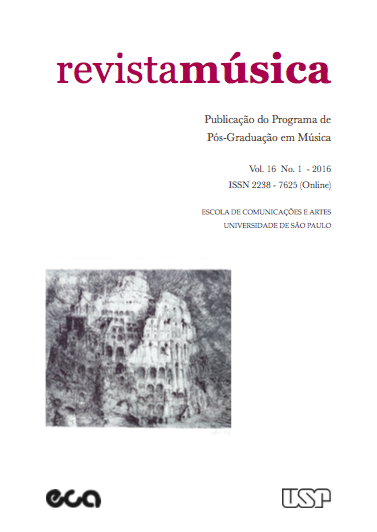Pronuntiatio in Silvestro Ganassi ́s Works (1492-c.1557)
DOI:
https://doi.org/10.11606/rm.v16i1.125014Keywords:
Renaissance, musical rhetoric, Silvestro Ganassi.Abstract
This paper aims to point out in Silvestro Ganassi’s work the presence of classical oratory concepts widely cultivated in the Venetian environment between the 1530s and 1540s. The influence of these elements in the author’s work is noted for the high degree of sophistication of content and the constant comparison between the two arts, especially with regard to the parts of speech dealing with the pronunciation, which in this case is directly related to musical performance. Taking into account the Venetian political environment and the humanistic ideas circulating within the literary academies of the city in the sixteenth century, we intend to make selection of several passages in the work of Ganassi who make direct or indirect reference to the art of oratory, so that, to relate them to their respective sources, we have a greater understanding of the meaning that the musical performance acquired in this environment.Downloads
References
DOLCE, Lodovico. Dialogo della Pittura Intitolato L’ Aretino. In: BAROCCHI, Paola (ed.). Trattati d’arte del Cinquecento. Bari [Venetia]: Laterza, 1960 [1557].
FELDMAN, Martha. City Culture and the Madrigal at Venice. Berkeley: University of California Press, 1995.
GANASSI, Silvestro. Lettione Seconda. Bologna [Venetia]: Arnaldo Forni Editore [ad instantia de l’autore], 1978 [1543].
______. Opera Intitulata Fontegara. Bologna [Venetia]: Arnaldo Forni Editore [ad instantia de l’autore], 2002 [1535].
______. Regola Rubertina. Bolonha [Venetia]: Arnaldo Forni Editore [ad instantia de l’autore], 1984 [1542].
GRIFFTHS, John. Las vihuelas em la época de Isabel la Católica. Cuadernos de Música Iberoamericana. Madrid, v. 20, p. 27-28, 2010.
KRISTELLER, Paul Oskar. Humanist Learning in the Italian Renaissance. In: Renaissance Thought and the arts: Collected Essays. Princeton, New Jersey: Princeton University Press, 1990, p. 1-19.
__________. Music and Learning in the Early Italian Renaissance. In: Renaissance Thought and the arts: Collected Essays. Princeton, New Jersey: Princeton University Press, 1990, p. 142-162.
PALISCA, Claude. Music and Ideas in the Sixteenth and Seventeenth Centuries. Urbana, Chicago: University of Illinois Press, 2006.
PINO, Paolo. Diálogo sobre a pintura (Veneza, 1548). Cadernos de Tradução. São Paulo, n.8, 2002 (trad. Rejane Bernal Ventura).
QUINTILIANO, Marco Fabio. Insititutio Oratoria. London: Harvard University Press, 1920-1922 (Loeb Classical Library).
ROSAND, Ellen. La musica nel mito di Venezia. In: TAFURI, Manfredo (ed.). Renovatio Urbis. Venezia nell’età di Andrea Gritti (1523-1538). Roma: Oficina Einaudi, 1984, p. 167-186.
SMITH, Anne. The Performance of 16-th Century Music. Learning from Theorists. Oxford: Oxford University Press, 2011.
TAFURI, Manfredo. Renovatio urbis Venetiarum: il problema storiografico. In: Renovatio Urbis. Venezia nell’età di Andrea Gritti (1523-1538). Roma: Oficina Einaudi, 1984, p. 9-56.
TETTAMANTI, Giulia da Rocha. Silvestro Ganassi: Obra Intitulada Fontegara. Um estudo sistemático do tratado abordando aspectos da técnica da flauta doce e da música instrumental do século XVI. Dissertação de Mestrado. Instituto de Artes, Universidade Estadual de Campinas (UNICAMP), Campinas, 2010.
WILSON, Blake McDowell. ‘Ut oratoria musica’ in the Writings of Renaissance Music Theorists. In: MATHIESEN, Thomas J. e Benito. V. Rivera (eds.). Festa Musicologica: Essays in Honor of George J. Buelow. Styvesant, NY: Pendragon Press, 1995, p. 341-368.
Downloads
Published
Issue
Section
License
Copyright (c) 2016 Giulia da Rocha Tettamanti

This work is licensed under a Creative Commons Attribution-NonCommercial-ShareAlike 4.0 International License.
Autores que publicam nesta revista concordam com os seguintes termos:
- Autores mantém os direitos autorais e concedem à revista o direito de primeira publicação, com o trabalho simultaneamente licenciado sob a CC Attribution-NonCommercial-ShareAlike 4.0 que permite o compartilhamento do trabalho com reconhecimento da autoria e publicação inicial nesta revista.
- Autores têm autorização para assumir contratos adicionais separadamente, para distribuição não-exclusiva da versão do trabalho publicada nesta revista (ex.: publicar em repositório institucional ou como capítulo de livro), com reconhecimento de autoria e publicação inicial nesta revista.
- Autores têm permissão e são estimulados a publicar e distribuir seu trabalho online (ex.: em repositórios institucionais ou na sua página pessoal) a qualquer ponto antes ou durante o processo editorial, já que isso pode gerar alterações produtivas, bem como aumentar o impacto e a citação do trabalho publicado (Veja O Efeito do Acesso Livre).


